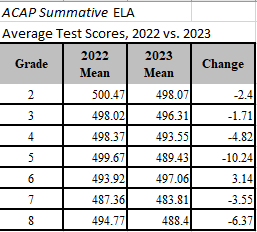The Alabama State Board of Education voted on Thursday to change the test score students must earn to be considered reading on grade level by the end of third grade. The change was recommended by testing experts due to changes made in the content of the 2023 test and shifts in results.
Using the score the state had in place, 24% percent of third graders who took the state standardized test in the spring of 2023 would have scored below the grade level reading mark. Using the target adopted by the board on Thursday, 17% of those students would have scored below grade level.
The grade-level reading target will take on increased importance this spring when the retention provision of the Alabama Literacy Act takes effect. At that point, students testing below grade level by the end of third grade could be held back. (Students will have a chance to get up to grade level during an intensive summer literacy camp. Other exemptions and methods of evaluation are also available).
The second and third-grade reading cut score changes received the most attention because of the implications. However, the changes to the state standardized tests of English Language Arts (ELA) were made across all grades in 2023. Along with changes in test content, the test scale was shifted, and proficiency cut scores adjusted. The changes make performance comparisons and trends across years difficult to interpret.
The Alabama Comprehensive Assessment Program (ACAP) is a series of standardized tests specifically built for Alabama, designed to test students at each grade level as they progress through the Alabama’s courses of study in English Language Arts, Math, and Science.
The original ACAP reflected the course of study in place in 2020. However, in 2021, the state adopted a revised ELA course of study. That revised course of study included a heightened focus on reading skills as called for by the Alabama Literacy Act. Changes to the course of study included:
- phonemic awareness and fluency added in grades 2-3;
- phonics added in grades 2-5
- listening skills added in grades 2-8
- text-dependent writing added to grades 2-3
- Recognizing and producing writing in different modes: narrative, informational, and opinion writing added in grades 2-8
Thus, with new concepts and points of emphasis added to the test, the test results were re-examined in light of the changes. Cut scores for the four achievement levels were adjusted. As a result, the test score a student needed to be considered proficient, i.e. scoring at either level 3 or level 4, was changed.
Comparing 2023 and 2022 results, average numeric scores in 2023 were lower in every grade but 6th. However, since the tests were changed and the scales were changed, the state department recommends against comparing scores from year to year.
While mean scores were down, proficiency rates were generally up. The percentage of students earning a score in the proficient range increased in all grades except third and eighth, where proficiency declined by 1% and 3%, respectively. The biggest jump in proficiency was in fifth grade, where the percentage of students scoring proficient jumped 9 percentage points. That is despite a large decline in the numeric mean score in 5th grade.
Because the tested material changed and the test scale was shifted, it is difficult to say if the score changes and proficiency changes were due to changes in student performance, changes in the scoring, or a combination of those and other factors.
Three of eight State Board of Education members voted against lowering the cut score that determines which students are reading below grade level. Those members expressed concern that students who weren’t prepared for the next academic level would be promoted and find themselves far behind and without the literacy support available in the early grades.
However, the majority of board members expressed support for following the advice of testing experts, recognizing that students this year were essentially taking a new test that required a new evaluation of results. Even with the lower cut scores, education officials are expecting a sharp increase in the number of students being required to repeat third grade in order to catch up in reading.
About half the states have some sort of retention provision. Alabama’s approach is modeled after Florida and Mississippi efforts. Both those states have seen large gains in reading on national assessment after implementing a systematic approach to literacy instruction.
Like those states, Alabama has dramatically increased funding and professional development for reading instruction and has especially targeted schools and systems with high concentrations of struggling readers.

